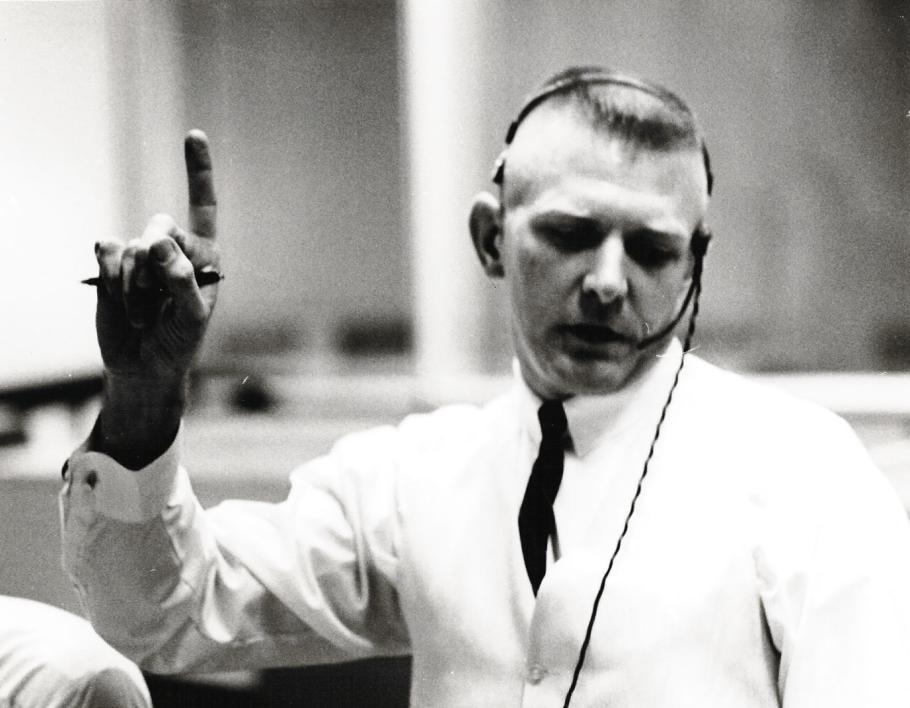Apollo 1
On January 27, 1967, the Apollo launch team was hard at work at Launch Pad 34 on Cape Canaveral. A full dress rehearsal was in progress for the Apollo 1 mission, the first manned mission in the Apollo Program, set for
take-off on February 21. NASA astronauts Gus Grissom, Edward White and Roger Chaffee were strapped in their seats in their command module atop a Saturn IB rocket. Their mission would test this new spacecraft in Earth orbit. All future Apollo crews would rely on this capsule to see them safely on their journeys to and from the moon. At 6:31 p.m., the unthinkable happened. One of the astronauts, Chaffee reported, “Fire, I smell fire.” Two seconds later White was heard saying, “Fire in the cockpit.” The fire spread throughout the cabin in a matter of seconds. The last crew communication ended 17 seconds after the start of the fire, followed by loss of all telemetry.
The Apollo hatch could only open inward and was held closed by a number of latches which had to be operated by ratchets. It was also held closed by the interior pressure, which was higher than outside atmospheric pressure and required venting of the command module before the hatch could be opened. It took at least 90 seconds to get the hatch open under ideal conditions. Because the cabin had been filled with a pure oxygen atmosphere at normal pressure for the test and there had been many hours for the oxygen to permeate all the material in the cabin, the fire spread rapidly and the astronauts had no chance to get the hatch open.
take-off on February 21. NASA astronauts Gus Grissom, Edward White and Roger Chaffee were strapped in their seats in their command module atop a Saturn IB rocket. Their mission would test this new spacecraft in Earth orbit. All future Apollo crews would rely on this capsule to see them safely on their journeys to and from the moon. At 6:31 p.m., the unthinkable happened. One of the astronauts, Chaffee reported, “Fire, I smell fire.” Two seconds later White was heard saying, “Fire in the cockpit.” The fire spread throughout the cabin in a matter of seconds. The last crew communication ended 17 seconds after the start of the fire, followed by loss of all telemetry.
The Apollo hatch could only open inward and was held closed by a number of latches which had to be operated by ratchets. It was also held closed by the interior pressure, which was higher than outside atmospheric pressure and required venting of the command module before the hatch could be opened. It took at least 90 seconds to get the hatch open under ideal conditions. Because the cabin had been filled with a pure oxygen atmosphere at normal pressure for the test and there had been many hours for the oxygen to permeate all the material in the cabin, the fire spread rapidly and the astronauts had no chance to get the hatch open.

Astronauts (left to right) Gus Grissom, Ed White, and Roger Chaffee, pose in front of Launch Complex 34 which is housing their Saturn 1 launch vehicle 2nd image after burning.
Nearby technicians tried to get to the hatch but were repeatedly driven back by the heat and smoke. By the time they succeeded in getting the hatch open roughly five minutes after the fire started the astronauts had already perished, probably within the first 30 seconds, due to smoke inhalation and burns. In the accident’s aftermath, the NASA family was distraught but determined to honour their fallen colleagues.
Flight Director Gene Kranz told his team at the Manned Spacecraft Center in Houston: “From this day forward, Flight Control will be known by two words: ‘tough’ and ‘competent.’ ‘Tough’ means we are forever accountable for what we do or what we fail to do. ‘Competent’ means we will never take anything for granted.”
 |
| Flight Director Gene Kranz |
The Apollo program was put on hold while an exhaustive investigation was made of the accident. It was concluded that the most likely cause was a spark from a short circuit in a bundle of wires that ran to the left and just in front of Grissom’s seat. The large amount of flammable material in the cabin in the oxygen environment allowed the fire to start and spread quickly. A number of changes were instigated in the program over the next year and a half, including designing a new hatch which opened outward and could be operated quickly, removing much of the flammable material and replacing it with self-extinguishing components, using a nitrogen-oxygen mixture at launch, and recording all changes and overseeing all modifications to the spacecraft design more rigorously.
No comments:
Post a Comment
Know about wonder of our universe Plz visit science city kapurthala, punjab .